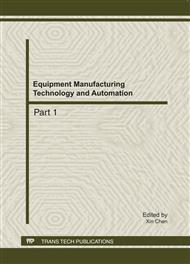p.1132
p.1136
p.1143
p.1149
p.1153
p.1163
p.1168
p.1172
p.1177
RFID-Based Thermal Bubble Non-Floating Type Accelerometer with Semi-Cylindrical Chamber and Filled with Xenon Gas
Abstract:
This research proposes a wireless RFID-based thermal bubble accelerometer design, and relates more particularly for the technology to manufacture and package it on a flexible substrate. The key technology is to integrate both a thermal bubble accelerometer and a wireless RFID antenna on the same substrate, such that the accelerometer is very convenient for fabrication and usage. In this paper the heaters as well as the thermal sensors are directly adhering on the surface of the flexible substrate without the traditional floating structure. Thus the structure is much simpler and cheaper for manufacturing, and much more reliable in large acceleration impact condition without broken. Furthermore, the molecular weight of xenon gas is much larger than carbon dioxide, thus the performance of the accelerometer will be increased. In addition, the shape of the chamber is changed as a semi-cylindrical one instead of the conventional rectangular type. Comparisons of sensitivity and response time are also made; one can see the performances of the proposed new design with either semi-cylindrical chamber or filled with xenon gas are better.
Info:
Periodical:
Pages:
1153-1162
Citation:
Online since:
August 2011
Authors:
Price:
Сopyright:
© 2011 Trans Tech Publications Ltd. All Rights Reserved
Share:
Citation:


